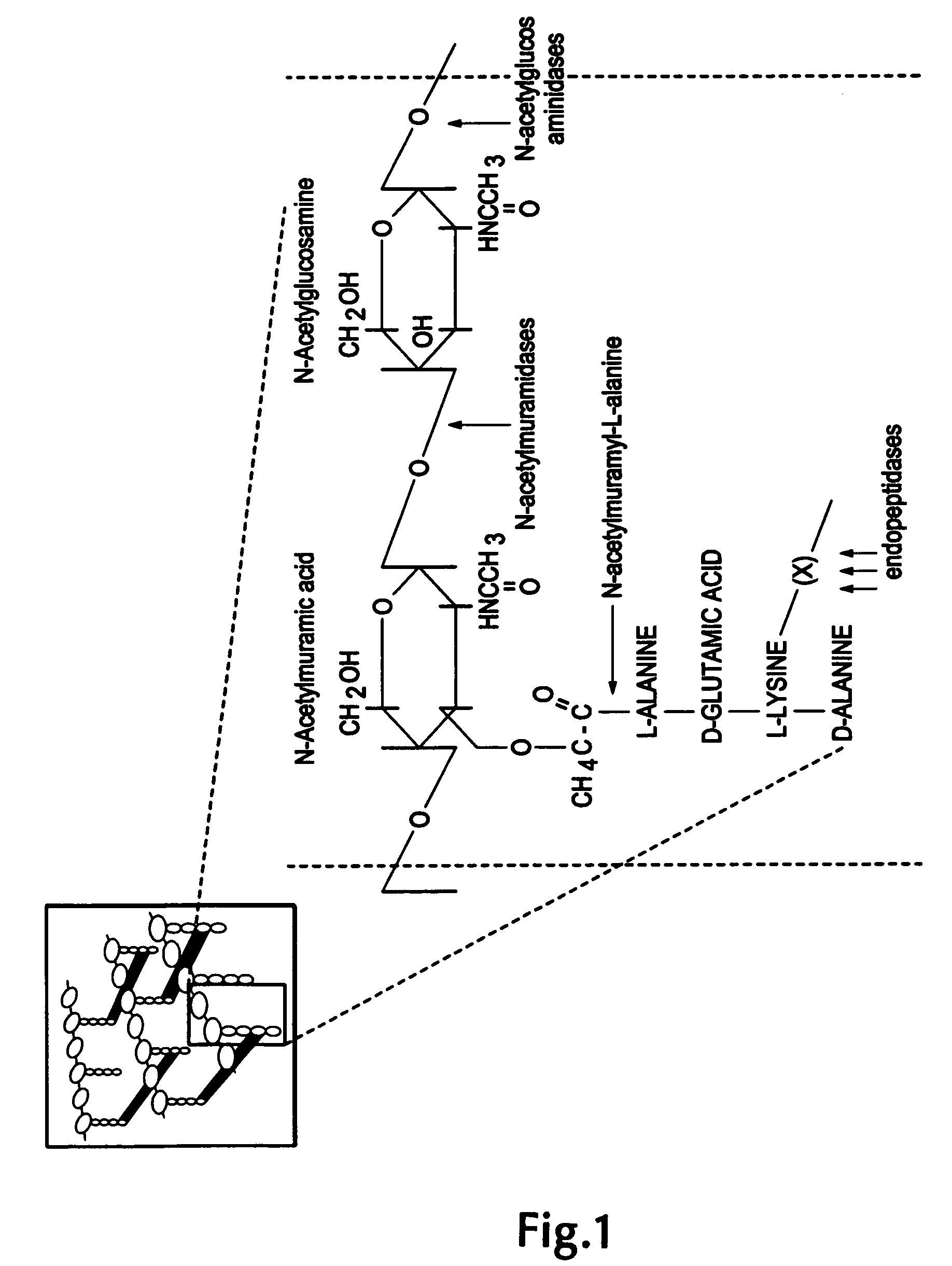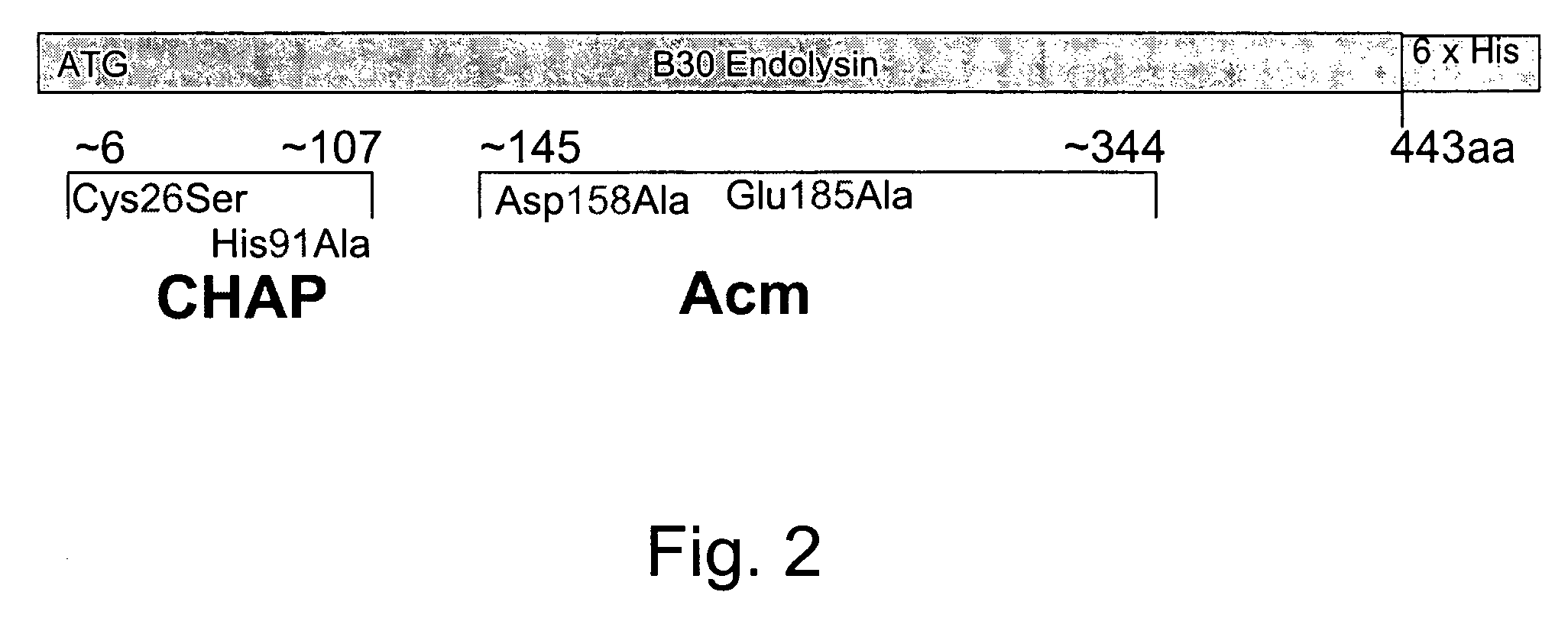Nucleic acid encoding endolysin fusion protein
a technology of endolysin and fusion protein, which is applied in the direction of fusion cells, peptides, enzymology, etc., can solve the problems of multidrug resistance, the cost of these dynamics is also rising, in terms of mortality, disability, and dollars, so as to reduce the potential for resistance development, prevent damage to commercially important organisms, and reduce the use of broad-range antibiotics
- Summary
- Abstract
- Description
- Claims
- Application Information
AI Technical Summary
Problems solved by technology
Method used
Image
Examples
example 1
Plasmid Constructions
[0063]The fusion of lysostaphin to both the truncated (182 amino acid) and full length (443 amino acid) endolysin constructs utilized a lysostaphin construct (BLG-lys; SEQ ID NO:3) which has been reported previously (Kerr et al. 2001. Nat Biotechnol. 19(1): 66-70). In BLG-lys, the lysostaphin coding region had been previously truncated to remove the 143 amino acid bacterial signal peptide, and mutated to change two asparagine residues (amino acid #s 125, 232) into glutamine residues (to remove putative eukaryotic oligosaccharide attachment sites). The lysostaphin protein (SEQ ID NO:4) produced is the mature form, 246 amino acids in length. The BGL-lys construct harboring the sequences that encode the mature form was restriction enzyme-digested with NotI and XbaI to isolate a ˜4 kb fragment harboring the entire 246 amino acid protein coding region, a ˜600 bp bovine growth hormone polyA addition region and ˜2.5 kb of bovine beta-lactoglobulin 3′ proximal gene sequ...
example 2
Growth of Bacteria, Extract Preparation, Protein Purification and Analysis
[0064]All assays were performed on extracts of E. coli BL21 (DE3) (Novagen) cells harboring the constructs described above. Cell extracts were prepared by growth of bacteria in 100 ml Superbroth, 100 μg / ml Ampicillin at 37° C. with shaking. At midlog phase (A660 of 0.3-0.5), induction of the T7-lacZ hybrid promoter was achieved with a final concentration of 1 mM IPTG followed by incubation at 37° C. with shaking for 3-4 hours. Cells were then pelleted and washed 3× with Lysin Buffer A (50 mM Ammonium Acetate, 10 mM CaCl2, 1 mM DTT pH 6.2), and pellets frozen at −80° C. Pellets could be thawed and resuspended (up to 20 days later) in 1 ml Lysin Buffer A, disrupted with 6×5 second pulses of sonication on ice with 5 second rest periods between pulses. Lysates were cleared with a 10 minute spin in a microfuge at 4° C., filter-sterilized through a Millex 0.22 micron pore sterile filter and stored at −80° C. for up ...
example 3
Generation of Deletion Mutant pDMD90
[0068]The 443 codon B30 endolysin gene was subcloned between the unique NdeI and XhoI sites of the parent pET21a (Novagen) vector by Pritchard et al. (supra) which added two codons at the carboxyl terminus. pET21a has a lacZ-T7 promoter fusion for high level expression induction with IPTG and a series of six in-frame Histidine codons which add a His Tag at the C-terminus of the resultant endolysin protein. The B30 endolysin gene fragment encoding the first 90 amino acids was subcloned back into the parent vector pSD101 (after removal of the full length endolysin gene). The 90 codon harboring DNA fragment was amplified using two oligonucleotides as PCR primers, each with the following sequences: forward primer BGLF: 5′-TCC GGC GTA GAG GAT CGA GAT 3′ (SEQ ID NO:5) and reverse primer 90R: 5′-TGC TAC ATG CTC GAG AGG CGT 3′ (SEQ ID NO:6). The forward primer overlaps the BglII site located immediately 5′ to the T7 promoter region in the pSD101 expressio...
PUM
| Property | Measurement | Unit |
|---|---|---|
| osmotic pressure | aaaaa | aaaaa |
| temperature | aaaaa | aaaaa |
| pH | aaaaa | aaaaa |
Abstract
Description
Claims
Application Information
 Login to View More
Login to View More - R&D
- Intellectual Property
- Life Sciences
- Materials
- Tech Scout
- Unparalleled Data Quality
- Higher Quality Content
- 60% Fewer Hallucinations
Browse by: Latest US Patents, China's latest patents, Technical Efficacy Thesaurus, Application Domain, Technology Topic, Popular Technical Reports.
© 2025 PatSnap. All rights reserved.Legal|Privacy policy|Modern Slavery Act Transparency Statement|Sitemap|About US| Contact US: help@patsnap.com



